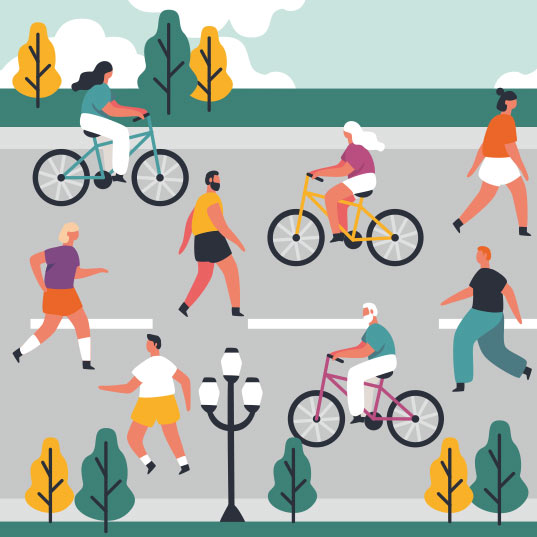Cities free of cars powered by fossil fuels enrich us. The benefits extend to our health, environment, quality of life and social cohesion. The local economy, too. An example is Copenhagen, the Danish capital, which has earned 400,000 from every kilometer of cycle lane in the city, showing that sustainable mobility can be profitable and beneficial. We explain the importance of this below.
What will I learn from this article?
- Toward a more profitable and sustainable urban mobility
- How northern Europe is transforming its mobility
Toward a more profitable and sustainable mobility
 Combustion vehicles, which run on petrol or diesel, are one of the main sources of pollution in the air of our cities. They emit over half of the harmful particles we inhale, according to the Union of Concerned Scientists. This pollution has serious consequences for human health.
Combustion vehicles, which run on petrol or diesel, are one of the main sources of pollution in the air of our cities. They emit over half of the harmful particles we inhale, according to the Union of Concerned Scientists. This pollution has serious consequences for human health.
A study published in Science of the Total Environment confirms that long-term exposure to fine particles emitted by cars can lead to respiratory and cardiovascular diseases. Cars generate 18% of CO2 emissions, the main gas behind the greenhouse effect, says the United Nations Human Settlements Programme (UN-Habitat).
With this data in mind, some cities decided to change the mobility on their streets and highways. The aim being to reduce the presence of polluting cars (i.e. those running on petrol or diesel). The main measures included pedestrianizing spaces, increasing cycle lanes and restricting combustion vehicle access to centers.
How northern Europe is transforming its mobility
Oslo is one of these cities which has left behind the snarl of combustion engines for a cleaner mobility without emissions. A milestone which saw it, among other factors, reach the top of the Sustainable Cities ranking compiled by consultancy ARCADIS with UN-Habitat.
The Norwegian capital has spent years investing in a sustainable transport system. In fact, Norway now stands out as a paradise for electric cars. Last year, nine out of 10 cars sold were electric, leading to a market share of almost 80%.
After years of incentives favoring electric over combustion cars, the Norwegian government is now trying to persuade residents to use public transport rather than private vehicles.
“In Norway, nine out of 10 cars sold are electric, leading to a market share of nearly 80 %".
 A goal in which cities like Copenhagen are also forging ahead. The Danish capital is close to becoming a car-free city. Since the 1970s, it has pursued a clear objective: promote the use of bicycles. To achieve this, it has invested in the creation of an extensive network of cycle lanes that facilitate safe, efficient travel by cyclists.
A goal in which cities like Copenhagen are also forging ahead. The Danish capital is close to becoming a car-free city. Since the 1970s, it has pursued a clear objective: promote the use of bicycles. To achieve this, it has invested in the creation of an extensive network of cycle lanes that facilitate safe, efficient travel by cyclists.
The results of these policies are clear to see and speak for themselves. In just five decades, and thanks to nearly 400 kilometers of cycle lanes, it has made cycling the preferred option of its citizens. Fifty-six percent of the capital’s inhabitants use the bicycle every day to move around; 20% opt for public transport, while just 14¡% use the car.
The scope of these plans goes beyond improving air quality. As part of its ambition to become an ‘eco-metropolis’ leader, the Danish capital includes car- and bicycle-related costs and economic benefits in its decision-making.
For every kilometer of bike lane, Copenhagen generates 400,000 euros of savings a year by reducing transport, healthcare and accident costs. According to one study, the city gains 16 cents for every kilometer traveled by cycle lane. The analysis reveals that every kilometer traveled in car or bicycle supposes a cost for society, but the cost of driving a petrol- or diesel-powered car is more than six times (0.50 euros/km) that of a bicycle (0.08 euros/km).
“For every kilometer of bike land, Copenhagen generates 400,000 euros of savings a year”.
There are other benefits that improve people’s quality of life, such as time Danes save every year by avoiding road congestion. Copenhagen profits from its lower traffic. To get an idea, if London’s residents lose 156 hours annually in traffic jams (almost a whole week), in the Danish capital, they save 32 hours. Sustainable mobility gains us time!
To summarize, reducing use of petrol and diesel cars doesn’t only have a positive impact on the environment, but also contributes considerable economic benefits and significantly improves air quality, reducing health risks associated with atmospheric pollution. The examples of Oslo and Copenhagen show us the benefits they obtained that lead to other forms of mobility.
Sources:
- https://www.climatica.lamarea.com/calles-sin-coches-peatonalizacion/
- https://www.sostenibilidad.com/construccion-y-urbanismo/historia-movilidad-urbana-sostenible/